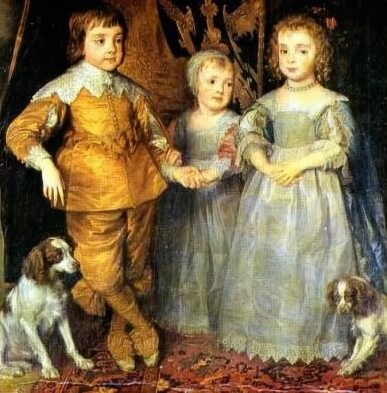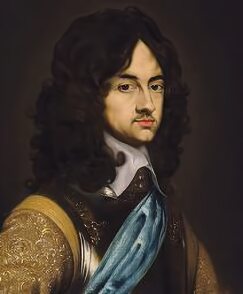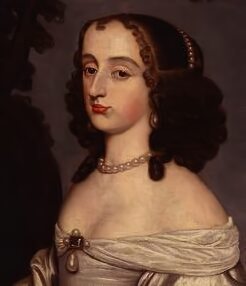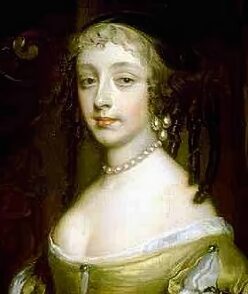1609-1669. Early Life
The daughter of Henry IV of France and his second wife, Marie de Medici, Henrietta Maria was born at the Palais du Louvre, on 25th November 1609.
The child was of decidedly mixed European ancestry, her father, the good humoured and compassionate Henry IV, was the son of the French Antoine de Bourbon, Duc de Vendôme and Jeanne III, Queen of Navarre, who was half French and half Spanish. Henrietta Maria's mother, Marie d' Medici contributed both dark Italian and Austrian Habsburg characteristics to the gene pool of the French royal house, she was the daughter of Francesco I de' Medici, Grand Duke of Tuscany and of Johanna, Archduchess of Austria, was herself the granddaughter of Phillip I and Joanna 'the Mad' of Castille.
Henrietta Maria of France
Henry IV and Marie de Medici produced six children of which Henrietta Maria was the youngest. Her siblings included King Louis XIII of France, Elisabeth, who became the consort of Phillip IV of Spain, Christine Marie, who became Duchess of Savoy, Nicholas Henri, Duke of Orléans and the wayward Gaston Jean-Baptiste, Duke of Orleans.
King Henry IV, although a popular King of France, was assassinated in Paris by a fanatic Catholic, before the infant Henrietta Maria was but a year old. Her mother was banished from the French court by her brother the new king in 1617. She was brought up a strict Roman Catholic and grew into a thin, adolescent with protruding teeth. A contemporary, Sophia of Hanover, the daughter of Elizabeth of Bohemia provides an unflattering description of Henrietta Maria as "a short woman perched on her chair, with long bony arms, irregular shoulders and teeth protruding from her mouth like a fence" but in a kinder vein, she added that she possessed "beautiful eyes, a well shaped nosed and an admirable complexion".
Marriage
With the aid of a special dispensation from the Pope, a marriage was arranged with the new English sovereign, King Charles I, Louis XIII consented to the match on the condition that some measure of toleration would be afforded to Roman Catholics in England. The couple were married by proxy on 11th May 1625. They were married in person at St. Augustine's Church, Canterbury, Kent, on 13th June 1625. Henrietta was at the time 15 years old and Charles 24, the arch-Catholic Henrietta Maria was to prove an unpopular choice of bride amongst Charles' Protestant subjects. The new Queen of England and Scotland was not crowned beside her husband at Westminster Abbey, since her rigid Catholicism would not allow her to swear the necessary Anglican oath required in the ceremony.
The relationship did not get off to a particularly good start, Charles found his wife frigid and when he eventually sent her accompanying expensive Roman Catholic retinue home to France, the Queen felt homesick and neglected. The attentions of her husband were reserved for his favourite, the Duke of Buckingham and frequent arguments between the couple resulted. On the assassination of Buckingham in 1628, Charles transferred his affections to his wife, after which their relationship grew far stronger and they were to become devoted to each other.
The eldest 3 children of Charles I and Henrietta Maria, Charles, Prince of Wales, James, Duke of York and Princess Mary
The first child of the marriage, Charles James, Duke of Cornwall, was born prematurely and died the same day in March, 1629, but was replaced by a much larger and healthier brother, Charles, (the future Charles II) born on 29 May 1630. The Queen's brother and mother, Louis XIII of France and Marie de Medici, stood as godparents to the new Prince of Wales. The couple were to eventually produce a large family of nine children.
The Queen did much to encourage her unpopularity amongst the country's majority Protestant element by meddling in affairs of state. When rumours reached the King's ears that Parliament intended to impeach his Queen, he was spurred into action. Led on by the outraged Queen, he went to the House of Commons on 4th January 1642, to arrest the five members who were perceived to be the most troublesome on charges of high treason, to find on his arrival that they had been forewarned and had fled.
As Civil War with Parliament war became inevitable, the Queen did much to aid her husband's cause and was active in seeking funds and support for the Royalist cause, she was on the continent at the outbreak of the war in 1642 but returned to England in early 1643. Landing at Bridlington in Yorkshire with men and arms, she established her base at York until meeting up with her husband at Oxford some months later.
The collapse of the Royalist cause led the Queen to flee to her native France in 1644, where she received a pension from the French court and lived with her youngest daughter Henrietta Anne. Following the end of the war, King Charles I was put on trial at Westminster Hall and executed at Whitehall in January 1649. It is reported that on receipt of the ominous news, Henrietta Maria stood "deaf and insensible" for a whole hour's duration, before regaining her senses. She was said to have never totally recovered from the shock of her husband's execution and dressed in black mourning for him for the rest of her life.
The monarchy was then abolished and England became a republic. During their exile in France, a rift developed between Henrietta Maria and her eldest son, Charles, now head of the family, when she attempted to convert her youngest son, Henry, to Catholicism. Henry, however, remained steadfast in his Protestantism. She later helped with the upbringing of her grandson, James Crofts, Duke of Monmouth, Charles' illegitimate son by Lucy Walters.
Following the Restoration, Henrietta Maria returned to England, where she lived at Somerset House in London. Parliament granted the Dowager Queen £30,000 a year in compensation for the loss of her estates and Charles II paid an additional annuity from his resources. She was at this time described by the diarist Samuel Pepys as " A very little, plain old woman". She was reported to be livid when her second son, James, Duke of York, married Anne Hyde, the daughter of Edward Hyde, Earl of Clarendon, Charles I's Lord Chancellor, she considered her son had married far beneath him. She returned to France to be present at the wedding of her youngest daughter, Henriette Anne, who was married to her foppish first cousin, Phillip, Duke of Orleans, the brother of Louis XIV, which took place on March 31, 1661. Both parties to the marriage were the grandchildren of Henry IV of France and Marie de' Medici.
In 1665, in failing health, she returned permanently to France where she founded a convent at Chaillot. Henrietta Maria died on 10th September 1669 at Château de Colombes, and lies buried in the royal tombs at the Cathedral of Saint-Denis near Paris. Her heart was interred separately at Chaillot in a silver casket.
The Ancestry of Henrietta Maria of France
Henrietta Maria of France
Father: Henry IV of France
Paternal Grandfather: Antoine de Bourbon
Paternal Great-grandfather: Charles, Duke of Vendôme
Paternal Great-grandmother: Françoise of Alençon
Paternal Grandmother: Jeanne III of Navarre
Paternal Great-grandfather: Henry II of Navarre
Paternal Great-grandmother: Marguerite of Angoulême
Mother: Marie de' Medici
Maternal Grandfather: Francesco I, Grand Duke of Tuscany
Maternal Great-grandfather: Cosimo I, Grand Duke of Tuscany
Maternal Great-grandmother: Eleanor of Toledo
Maternal Grandmother: Joanna of Austria
Maternal Great-grandfather: Ferdinand I, Holy Roman Emperor
Maternal Great-grandmother: Anna of Bohemia and Hungary
The Children and Grandchildren of Charles I and Henrietta Maria of France
(1) Charles James, Duke of Cornwall b. & d. 13 March, 1629.
Charles, Prince of Wales
(2) CHARLES II 29 May, 1630- 6 February, 1685
reigned May 1660- February 1685
Married Catherine of Braganza, the daughter of John II, Duke of Braganza and his wife, Luisa de Guzmán.
No legitimate issue.
Mary, Princess Royal
(3) Mary, Princess Royal 4 November, 1631-24 December, 1660
Married William II, Prince of Orange, son of Frederick Henry, Prince of Orange, and Amalia of Solms-Braunfels.
Issue:-
(i) WILLIAM III, Prince of Orange, King of England, Scotland and Ireland. 4 November 1650-8 March 1702 m. MARY II, daughter of James II, his first cousin.
James, Duke of York
(4) JAMES II & VII 14 October, 1633- 16 September, 1701
m. (1) Anne Hyde.Issue:-
(i) Charles, Duke of Cambridge 22 October, 1660-5 May, 1671
(ii) MARY II 30 April, 1662-28 December, 1694 m. WILLIAM III
(iii) James, Duke of Cambridge 12 July, 1663-22 May, 1667
(iv) QUEEN ANNE 6 February, 1665-1 August, 1714 m. George of Denmark
(v) Charles, Duke of Kendal 4 July, 1666-20 June, 1667
(vi) Edgar, Duke of Cambridge 14 September 1667-15 November, 1669
(vii) Henrietta 1`3 January, 1669-15 November, 1669
(viii) Catherine 9 February, 1671-5 December, 1671
married (2) Mary Beatrice of Modena. Issue:-
(ix) Catherine Laura 10 January, 1675-3 October, 1675
(x) Isabella 28 August, 1676-2 March, 1681
(xi) Charles 7 November, 1677-12 December, 1677
(xii) Elizabeth b. & d. 1678
(xiii) Charlotte b. & d. 1682
(xiv) James Francis Edward, Prince of Wales 10 June, 1688-1 January, 1766 m. Maria Clementina Sobieski
(xv) Louisa Maria Theresa 28 June, 1692-20 April, 1713
(5) Elizabeth 29 December, 1625-8 September, 1650
Elizabeth died of pneumonia on the Isle of Wight on 8 September 1650, while a prisoner of Parliament.
(6)Anne 17 March, 1637 8 December, 1640
(7) Catherine b. &d. 1639
Henry, Duke of Gloucester
(8) Henry, Duke of Gloucester 8 July-1640-18 September, 1660
Henry, also known as Henry of Oatland, died aged twenty-one after contracting smallpox in the autumn of 1660, just after the Restoration, he never married.
Henriette Anne
(9) Henriette Anne 16 June,1644-30 June, 1670
married Phillip, Duke of Orleans, son of Louis XIII of France and his queen Anne of Austria.
Issue:-
(i) Marie Louise d Orleans 27 March, 1662-12 February, 1689 m. Charles II of Spain
(ii) Phillip Charles, Duke of Valois 16 July, 1664-8 December, 1666
(iii) Anna Maria d' Orleans 27 August, 1669-26 August, 1728 m. Victor Amadeus of Savoy
Elizabeth Stuart PreviousNext Rupert of the Rhine
